Five Swiss specialties you (probably) haven’t tried yet

As a kid, I came to Switzerland every summer to visit my grandparents, and my introduction to Swiss food was gorging on cheese, Cervelat, Gipfeli, paprika chips, Migros Ice Tea, and Coupe Dänemark (plus my Aunt Vreni’s Birchermüesli and my grandmother’s Wähen).
After training to be a pastry chef in Canada, I moved to Switzerland and eventually married my Swiss sweetheart Sam, settling in the Emmental. With his (and Betty Bossi’s) help, I learned that Swiss cuisine is so much more than cheese and chocolate. Every region protects and celebrates its own contribution to the Swiss culinary canon, which for such a small country is incredibly large and diverse.
So, forget fondue and birchermüesli, here are five lesser-known Swiss food products that are definitely worth a taste.
Schabziger—Green Cheese
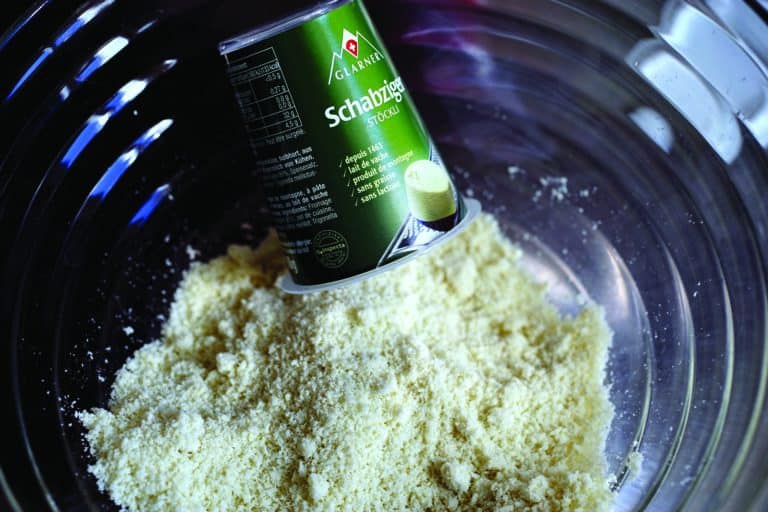
Unless you live in canton Glarus, you probably haven’t had a thin layer of green cheese grated over your fondue before you dip your bread.
That’s Schabziger—one of the most polarising contributions to Switzerland’s cheese canon. It’s a hard and crumbly cheese, cone shaped, and pale green. The green comes from blue fenugreek, which gives it an unusual aromatic flavour that some people dislike and others adore.
Schabziger dates from at least the ninth century. The people of Glarus paid tithes to the local monastery in the form of the white whey by-product of cheese making, called Ziger, which the nuns would then flavour and age.
It’s also Switzerland’s oldest protected brand. In 1463, Glarus held a Landsgemeinde, a council meeting in the town square where locals could vote on new laws by a show of hands (well, swords), which put forth the quality standards that were required for Schabziger—the same ones as today.
The taste of Schabziger is unique and for many, delicious. It’s often mixed with butter and used as a spread, or simply sprinkled over boiled potatoes, vegetables, pasta or fondue.
Where can I get it? You can get cones of Schabziger in most Swiss grocery stores, as well as Zibu (Schabziger mixed with butter) and Glarner Grüessli (a spread for bread and crackers). It is also exported to the States and beyond, sometimes under the name Sap Sago.
Turta da Nuschs—Sweets from the Engadine Valley
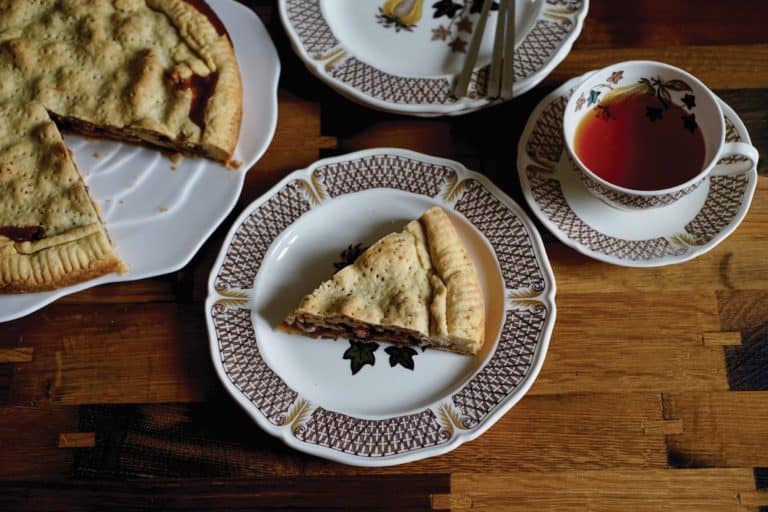
The Turta da Nuschs, or Engadiner Nusstorte as it is known in German, is a caramelly, walnut filled tart from the canton of Grisons. It’s the canton’s most popular cake and, due to its long shelf life, it’s often bought by tourists and brought home with them.
The history of the cake is linked to the Engadiner Zuckerbäcker. These were young bakers who fled poverty and military service in Grisons to work in restaurants, cafés, and bakeries throughout Europe. From the late middle ages onward, the Zuckerbäcker made a name for themselves as hard and thrifty workers, and for Swiss quality in general. They opened bakeries and cafés as far afield as Madrid and St Petersburg. With their successes abroad, they were able to send money back to their valleys and support their families and the communities they had left behind.
It was from these wandering bakers that the Turta da Nuschs originated. Although there are conflicting accounts, the most likely origin story is that the recipe was developed in the south of France, then brought back home by Zuckerbäcker from the Engadine valley (with some walnut trees in tow).
Where can I get it? Most Grisons bakeries will have their own version, and you can also find it in many Swiss supermarkets. You can also make your own—there are many recipes online.
Vacherin Mont d’Or—Lazy Fondue
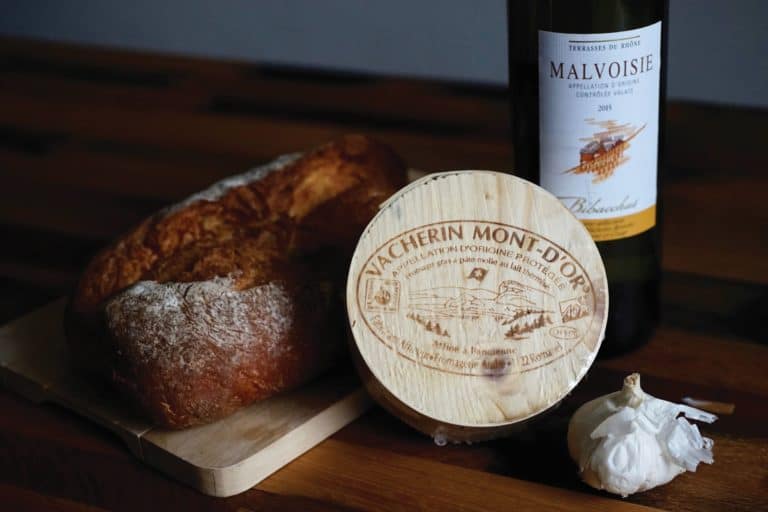
Vacherin Mont d’Or is a soft round cheese encased in spruce, which can be enjoyed like a mini fondue, complete with pot. You wrap the whole thing in foil, then stick it in the oven and voilà, dippable cheese.
The Swiss version is produced in the Jura region and is protected with an designation of origin. The casing is made from spruce, by hand, which lends its flavour to the cheese. It is made seasonally—in the winter when the cows descend from the Alps—and the Swiss variety is sold from exactly 15 September to 15 April.
There are currently only twelve Jurrasian affineurs who ripen the cheese. All the Swiss Mont d’Or in the world comes from their cellars.
Where can I get it? Swiss Vacherin Mont d’Or is sold from the middle of September to the middle of April in most supermarkets and cheese shops. You can also find it in specialty cheese shops throughout Europe and North America
Röteli—A Cherry Love Potion
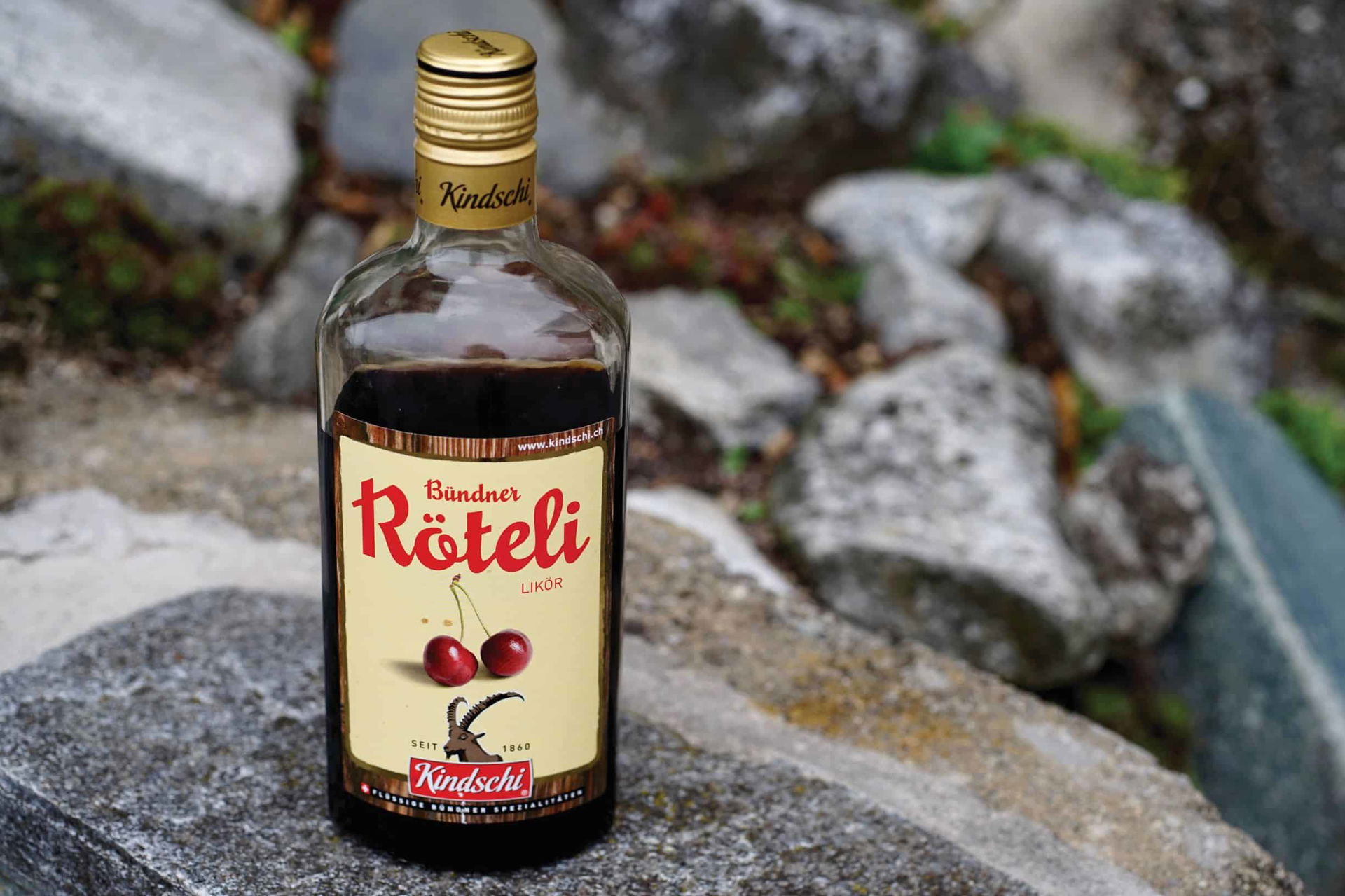
Röteli is a liqueur made with dried cherries and spices that dates from as early as the 19th century. It was traditionally made by families in Grisons, each using a different spice mixture. In the early 1900s traditional recipes were collected and experimented with, leading to a standardized version that could be mass produced.
It is traditional to drink Röteli on New Year’s Eve. In the olden days, Grisons bachelors would go from farmhouse to farmhouse visiting unmarried farmer’s daughters. At each farm they would sample a glass of Röteli that the single ladies (under the watchful eye of their mothers) had made. Some saw the drink as a kind of love potion, and often these visits would result in marriage proposals. The further back in the valley the bachelors went, the drunker they got, and the better looking and more appealing the daughters became, giving a big advantage to those who lived in remote farmhouses.
Where can I get it? There is a standard version of Röteli that is available in most Swiss spirit-selling shops. There are also more localised versions, that are available in the canto of Grisons.
Saucisson Vaudois—Sausages for Kings
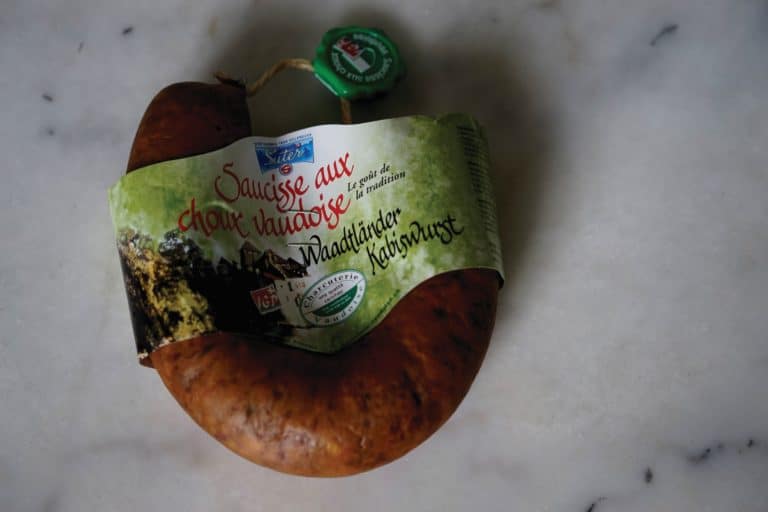
The sausages from canton Vaud are some of Switzerland’s best—notably the pure pork, Saucisson Vaudois, or Saucisse aux Choux Vaudois, which is mixed with cabbage.
Both of these sausages are protected with a designation of origin, meaning that they are made according to strict rules. They must be produced in canton Vaud, and they both must be smoked for a minimum of 24 hours. Other elements, like ratio of lean meat to bacon (3:2) in the Saucisson Vaudois and the meat makeup of the Saucisse aux Choux Vaudois (no tendons), is carefully controlled.
Legend has it that the Saucisse aux Choux Vaudois originated in 879 when German Emperor Charles the Fat visited the old Roman settlement of Orbe, today a small town in the canton of Vaud. Charles and his lackeys extended their stay, putting pressure on the supply of meat in the town. To make the meat last longer, the townspeople added cabbage and stuffed it in their sausages. Problem (deliciously) solved.
Where can I get it? These sausages are available in the fall and winter from most Swiss butchers and supermarkets.
Recipe: Papet Vaudois (as seen at top of page)
The easiest and tastiest preparation of these sausages is Papet Vaudois, where they are cooked on a bed of potatoes and leeks.
Ingredients:
knob of butter
3-4 large leeks, cleaned and cut into rings
500 g (1 lb) potatoes, cubed
250 ml (1 cup) water
125 ml (½ cup) white wine
salt and pepper
Saucisson Vaudois, Saucisse aux Choux Vaudoise, or other boiling (not frying) sausages of your choosing
Method:
Melt the butter in a deep and wide frying pan with a lid.
Add the leeks and cook over medium heat for about five minutes, until softened.
Add the potatoes, water, and wine, then increase the heat and to bring to a boil. Season with salt and pepper.
Place your sausage(s) of choice on top of the leeks and potatoes, cover, and simmer for about 25 minutes. Remove the lid and cook for an additional five minutes to let some of the liquid evaporate.
- Normally a Chasselas from the Swiss wine regions of Lavaux or Chablais in canton Vaud would be the perfect choice for cooking, and then drinking with the meal.
- The skin of the sausage is edible. Some people like to eat this, and some don’t.
- This could work with any number of boiling sausages, both Swiss and otherwise. Check the package for cooking times.
About the Author: Born in Canada to a Swiss mother, Andie Pilot has many happy memories of time spent in her Bernese grandmother’s kitchen. After training as a pastry chef in Canada, Andie moved to Bern, where she started the website Helvetic Kitchen in order to share her love of Swiss cooking with her friends in Switzerland and around the globe. The Helvetic Kitchen cookbook was published by Bergli Books in 2017, and her second book, Drink like the Swiss, in 2018. www.helvetickitchen.com
Read Andie’s article about 5 Swiss Winter Warming drinks
